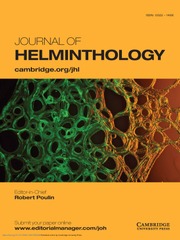Article contents
Description of a new species of the genus Anguillonema Fuchs, 1938 (Nematoda: Sphaerularioidea) with an identification key to the species
Published online by Cambridge University Press: 21 June 2018
Abstract
Anguillonema iranicum n. sp. is described and illustrated as the second species of this genus from Iran, based on morphological, morphometric and molecular characteristics. It is identified by a short, thin body, a continuous lip region, six lines on the lateral field, a short, thin stylet, a posteriorly located pharyngo-intestinal junction to excretory pore, the presence of a post-vulval uterine sac, vulval position at 89% (87.4–89.9%) of body length, an elongate conoid tail with a rounded to pointed tip and not dorsally bent, and common functional males with short spicules and lacking a bursa. Morphological differences between the new species and the three known species of the genus, namely A. amolensis, A. crenati and A. poligraphi, are discussed. Molecular phylogenetic studies of the new species using partial 18S rDNA sequence revealed that it formed a sister clade with three species of Howardula, one species of Anguillonema and one unidentified isolate. In phylogenetic analyses using partial sequences of 28S rDNA D2-D3 segment, the new species formed a clade with two isolates of Parasitylenchus. A key to identification of Anguillonema species is also presented.
Information
- Type
- Research Paper
- Information
- Copyright
- Copyright © Cambridge University Press 2018
References
- 1
- Cited by

